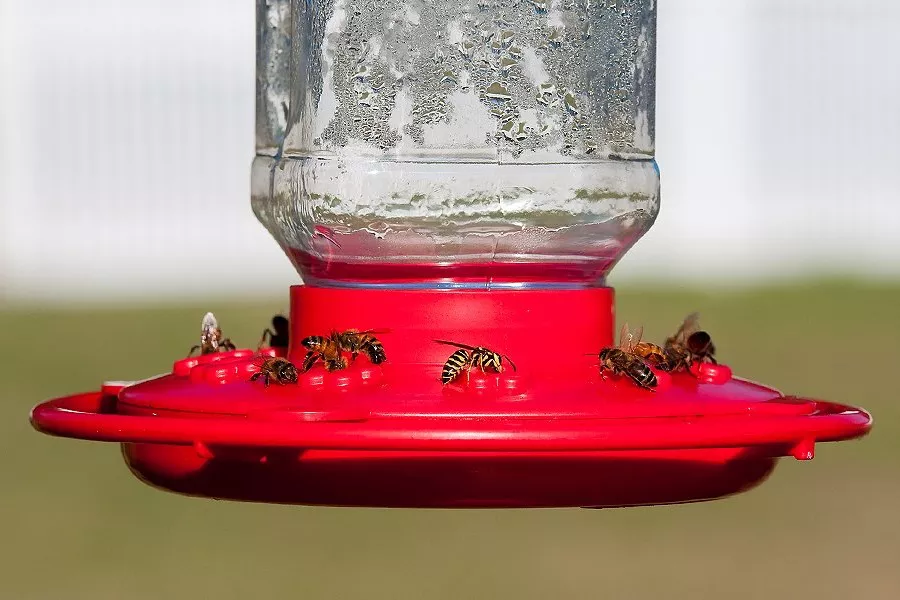Hummingbirds love sweet nectar, but so do bees. If too many bees visit a feeder, they can drive the hummingbirds away. This can be frustrating for bird lovers who want to enjoy watching these tiny, fast-flying creatures. Fortunately, there are many ways to keep bees away from hummingbird feeders without harming them. In this guide, we will explore 10 Best Ways to Keep Bees Away from Hummingbird Feeders.
Why Are Bees Attracted to Hummingbird Feeders?
Bees are naturally drawn to sugary foods. The sweet nectar in hummingbird feeders provides a rich energy source, just like flowers do. However, if flowers are scarce, bees may seek food elsewhere, including in feeders meant for hummingbirds. Bright colors, strong scents, and easy access make feeders a perfect target.
Are Bees Bad for Hummingbirds?
Bees are essential pollinators, and they help plants grow. However, when too many bees gather around a hummingbird feeder, they can cause problems:
Competition for food – Bees consume nectar, leaving less for hummingbirds.
Aggressive behavior – Some bees can become territorial and scare away hummingbirds.
Blocked feeding ports – A swarm of bees can cover the feeder, making it hard for hummingbirds to drink.
It is important to find a balance—keeping hummingbirds happy while protecting the bees.
10 Best Ways to Keep Bees Away from Hummingbird Feeders
1. Choose a Bee-Resistant Feeder
Not all feeders are the same. Some designs make it harder for bees to access the nectar. Look for:
- Saucer-style feeders – These have deep reservoirs that hummingbirds can reach with their long beaks, but bees cannot.
- Feeders with bee guards – These have mesh or plastic barriers that prevent bees from entering the feeding ports.
2. Use Red Feeders Instead of Yellow Ones
Bees are highly attracted to yellow. Many flowers that attract bees have yellow hues. Hummingbirds, on the other hand, prefer red. Choosing a red feeder can help reduce bee visits. If your feeder has yellow parts, consider painting them red or covering them with red tape.
3. Move the Feeder to a Different Location
Bees communicate with each other. Once they find a food source, they tell their hive where to go. If you move the feeder even a few feet away, bees may have trouble relocating it. Try:
- Moving the feeder to a shadier spot (bees prefer sunny locations).
- Placing the feeder in a different part of the yard every few days.
4. Keep the Feeder Clean
Sticky spills can attract bees quickly. If nectar drips onto the feeder or the ground, bees will come looking for more. To prevent this:
- Wipe the feeder regularly to remove sticky residue.
- Check for leaks and replace damaged feeders.
5. Use a Different Nectar Recipe
Standard hummingbird nectar is made from sugar and water. While this is perfect for hummingbirds, bees find it irresistible too. To discourage bees, try:
- Using a 5:1 water-to-sugar ratio instead of the common 4:1 ratio. This makes the nectar slightly less sweet, which is less attractive to bees but still good for hummingbirds.
6. Provide Alternative Food Sources for Bees
If bees are struggling to find food, they will be more likely to invade your feeder. To help them, try:
- Planting bee-friendly flowers like lavender, sunflowers, and wildflowers.
- Setting up a separate bee feeder with sugar water in a different part of your yard.
7. Adjust the Feeder’s Access Points
Bees can crawl into large feeding ports, but hummingbirds use their long tongues to drink. You can make it harder for bees by:
- Using smaller feeding holes that bees cannot fit into.
- Adding bee guards that allow only hummingbirds to access the nectar.
8. Use Natural Repellents
Some scents naturally repel bees but do not bother hummingbirds. These include:
- Peppermint oil – Applying a small amount around the feeder can help.
- Cinnamon – Sprinkling a bit near the feeder may discourage bees.
However, use these methods carefully and in small amounts. Hummingbirds have sensitive respiratory systems, so strong scents should not be overwhelming.
9. Avoid Pesticides
Some people may be tempted to use insecticides to get rid of bees, but this is harmful. Bees are important for the environment and should not be killed. Instead, use natural methods that discourage them without causing harm.
10. Reduce Direct Sunlight on the Feeder
Bees prefer warm, sunny spots. If you place the feeder in partial shade, it may attract fewer bees while still being visible to hummingbirds.
What to Do If Bees Keep Coming Back?
If bees continue to visit your feeder despite these changes, try combining multiple methods. For example:
- Use a bee-resistant feeder and keep it clean.
- Move the feeder to a shady location and change the nectar recipe.
- Offer alternative food sources for bees elsewhere in your yard.
With patience and persistence, you can find a solution that keeps both hummingbirds and bees happy.
Final Thoughts
Keeping bees away from hummingbird feeders takes effort, but it is possible. The key is to make the feeder less attractive to bees while still providing a good food source for hummingbirds. By using bee-resistant feeders, changing nectar recipes, and keeping feeders clean, you can enjoy watching hummingbirds without interference. At the same time, planting bee-friendly flowers and avoiding pesticides will help protect these essential pollinators.


 Facebook
Facebook  Instagram
Instagram  Youtube
Youtube 